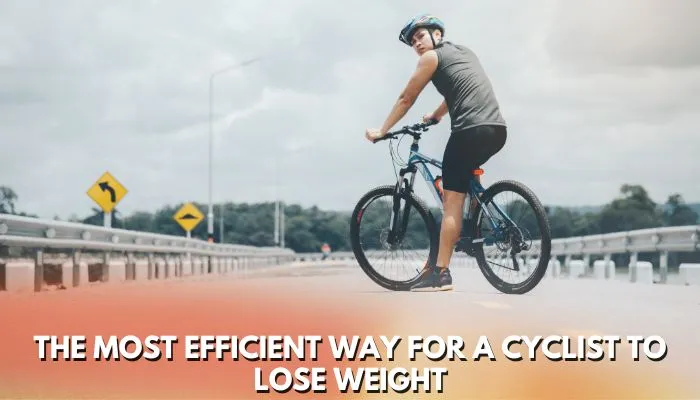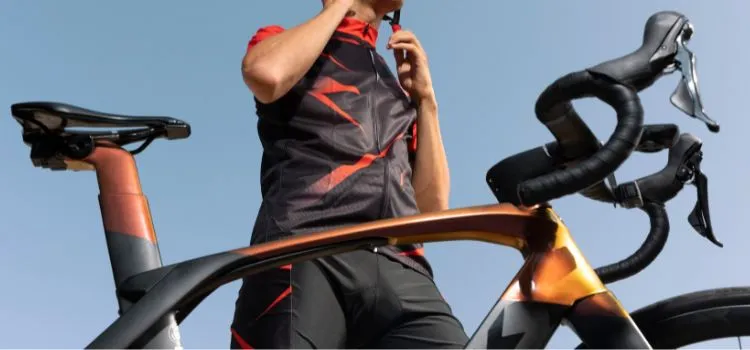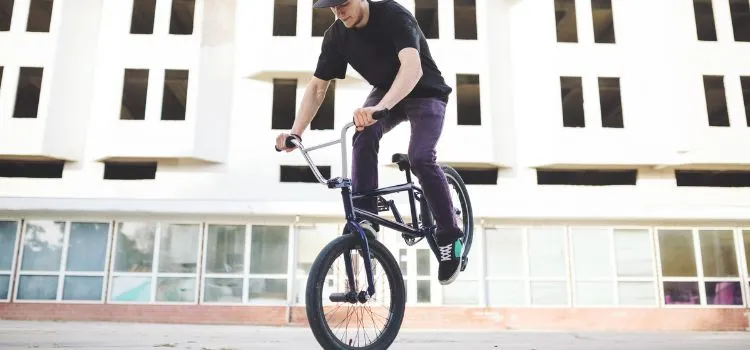The Most Efficient Way for a Cyclist to Lose Weight

Are you pressing the pedals to get rid of those extra pounds? Have you ever considered that what you consume after your ride is just as important as your physical activity? There’s no need to stress if you’re unclear about what to consume after a ride!
Table of Contents
Short Answer:
What to eat after cycling to lose weight? Examine foods that are high in protein as well as inadequate in calories after a workout. After exercise, protein aids in the restoration and regrowth of your body. These can be used with foods that are high in nutrients to provide a good dose of mineral and vitamin content.
The post-cycling meal suggestions that may help you lose weight are discussed in this article, along with an analysis of why they’re good for losing weight.
What To Eat After Cycling To Lose Weight | Post Meal Suggestions
After cycling to lose weight, it is important to eat a healthy and balanced meal that provides your body with the nutrients it needs to recover and build muscle. Here are some suggestions for post-cycling meals:
- Lean protein:
Chicken, fish, tofu, or beans are great sources of protein that can help repair and rebuild muscle tissue. Another fantastic protein source that is low in calories and ideal for weight loss is fish and chicken breast, which have been grilled. That is a significant source of important nutrients, such as B vitamins, which support your general well-being and health.
- Complex carbohydrates:
Whole-grain bread, brown rice, or quinoa provides sustained energy and helps replenish glycogen stores in your muscles. Greek yogurt with various berries, nuts, and seeds is a great source of protein, good fats, and complex carbohydrates.
Aside from reducing appetite, these nutrients also encourage weight loss. They include a wealth of important elements such as calcium and vitamin D, both of which support the health of the bones.
- Vegetables and fruits:
These provide essential vitamins, minerals, and fiber to aid digestion and overall health.
- Low-fat dairy or dairy alternatives:
Milk, yogurt, or plant-based alternatives such as soy or almond milk provide calcium and other nutrients that can help build strong bones.
- Healthy fats:
Avocados, nuts, and seeds are great sources of healthy fats that can help regulate hormones and provide energy.
- Smoothies
Smoothies are an excellent post-ride replenishment beverage. Smoothies can be prepared in advance, and they can be personalized by incorporating whey protein powder, fruits, and low-fat milk. To replace the electrolyte content, you can also sip coconut water.
- Nut Butter with Nuts
Because of their high calcium and protein content, nuts & nut butter help to maintain strong muscle and bone development, and combining almonds and some dried fruit can achieve the ideal carb-to-protein ratio. You could also spread nut butter over a piece of whole wheat bread and add a banana on top.
It’s important to avoid processed and high-fat foods, as these can slow down recovery and hinder weight loss progress. Additionally, be sure to stay hydrated by drinking plenty of water and electrolyte-rich fluids such as coconut water or sports drinks.
Is It Possible To Lose Weight After Cycling?

Yes, it is definitely possible to lose weight after cycling. Cycling is a great form of exercise that can help you burn calories and lose weight.
When you cycle, you engage a large number of muscles in your legs, which burns calories and helps to boost your metabolism. In addition, cycling is a low-impact exercise, which makes it a good option for people who want to avoid high-impact activities that may cause joint pain or injury.
To lose weight through cycling, it’s important to maintain a calorie deficit, which means that you consume fewer calories than you burn. This can be achieved by reducing your calorie intake through healthy eating habits and increasing your calorie expenditure through regular cycling workouts.
The amount of weight you can lose through cycling depends on a variety of factors, including your current weight, diet, and exercise routine. Still, with consistent effort, cycling can be an effective way to lose weight and improve your overall health.
Tips For Eating After Cycling To Promote Weight Loss
Suppose your goal is to lose weight after cycling. In that case, it’s important to eat a balanced meal that provides your body with the nutrients it needs to recover and repair after exercise while also helping you maintain a calorie deficit. Here are some tips for eating after cycling to promote weight loss:
- Focus on protein:
Eating protein after cycling can help repair and rebuild muscle tissue, which can help you recover from your workout and maintain muscle mass. Good sources of protein include lean meats, fish, tofu, beans, and legumes.
- Include complex carbohydrates:
Eating complex carbohydrates after cycling can help replenish your glycogen stores and provide sustained energy throughout the day. Good sources of complex carbohydrates include whole grains, fruits, and vegetables.
- Avoid processed foods:
Processed foods are often high in calories, unhealthy fats, and added sugars, which can slow down your weight loss progress. Instead, focus on whole, nutrient-dense foods that will nourish your body and help you maintain a calorie deficit.
- Stay hydrated:
Drink plenty of water and electrolyte-rich fluids to stay hydrated and support your body’s recovery after exercise. Body temperature is regulated by water in the form of hydration, which also facilitates the transportation of nutrients, decreases muscle soreness and exhaustion, and encourages hydration through devouring food.
- Be mindful of portion sizes:
Even with healthy foods, it’s important to be mindful of portion sizes to ensure you’re not consuming more calories than you’re burning. Consider using a food scale or measuring cups to help you portion your meals.
Remember, losing weight after cycling is about creating a calorie deficit through a combination of healthy eating and regular exercise. By fueling your body with nutritious foods and staying consistent with your cycling workouts, you can achieve your weight loss goals and improve your overall health.
Is It Easy To Lose Tummy Fat By Cycling?

Cycling is an excellent form of exercise that can help you burn calories and lose weight, including belly fat. In fact, cycling is considered one of the best cardio exercises for burning fat and improving overall fitness.
- Belly fat, also known as visceral fat, is the fat that collects around your midsection and is linked to several health problems, such as diabetes, heart disease, and high blood pressure. Losing belly fat can improve your health and reduce your risk of developing these conditions.
- Cycling is a low-impact exercise that can be done indoors or outdoors. It is a great way to burn calories and improve cardiovascular health, which can help reduce belly fat. Cycling can also help you build muscle, which can boost your metabolism and lead to further fat loss.
- When you ride a bike, you engage your core muscles, including your abs and lower back, which can help tone and tighten your midsection. This can lead to a reduction in belly fat over time.
- In addition, cycling is a form of aerobic exercise, which means it increases your heart rate and breathing rate, causing you to burn more calories. The more calories you burn, the more likely you are to lose weight and reduce belly fat.
- To get the most out of cycling for belly fat loss, it’s important to maintain a consistent exercise routine, ideally cycling for at least 30 minutes a day, five days a week. You can also increase the intensity of your cycling workouts by incorporating intervals or hill training, which can help you burn even more calories and fat.
- However, it’s important to note that cycling alone may not be enough to lose belly fat. To see significant results, it’s important to combine cycling with a healthy diet that includes plenty of fruits, vegetables, lean protein, and whole grains and to limit your intake of processed foods, sugar, and alcohol.
In conclusion, cycling is an effective way to lose belly fat, but it should be combined with a healthy diet and a consistent exercise routine for the best results. With dedication and commitment, cycling can help you achieve your weight loss and fitness goals while improving your overall health and well-being.
Proper Cycling Training Plan For Weight Loss

A cycling training plan for weight loss generally involves a combination of aerobic exercise and interval training, along with a healthy diet. Here are some general guidelines for creating a cycling training plan for weight loss:
1. Start with a warm-up:
Begin each cycling workout with a 10 to 15-minute warm-up at a low intensity to gradually increase your heart rate and prepare your muscles for exercise.
2. Focus on aerobic exercise:
Aerobic exercise is great for burning calories and improving cardiovascular health. Aim for at least 30 to 60 minutes of steady-state cycling at a moderate intensity, such as 70-80% of your maximum heart rate, several times a week.
3. Incorporate interval training:
Interval training involves alternating periods of high-intensity exercise with rest or low-intensity exercise periods. This training can help you burn more calories and improve your fitness level more quickly than steady-state exercise alone. Try incorporating intervals into your cycling workouts by doing short bursts of high-intensity cycling followed by periods of active recovery.
4. Increase the intensity and duration gradually:
To avoid injury and burnout, increase the intensity and duration of your cycling workouts gradually over time.
5. Combine cycling with strength training:
Strength training can help you build muscle mass, which in turn can help you burn more calories at rest. Consider adding two to three weekly strength training sessions to your cycling training plan.
6. Follow a healthy diet:
To maximize the benefits of your cycling training plan for weight loss, it’s important to follow a healthy diet rich in whole foods and low in processed foods, sugar, and saturated fat.
Remember to always consult with a doctor before starting any new exercise program, especially if you have any pre-existing medical conditions or injuries.
Measuring Cycling And Your Weight Reduction Success Story
To measure your cycling success, you can track your progress in terms of distance, speed, and time. You can use a cycling computer or a mobile app that tracks your rides to record your data.
Additionally, you can measure your progress by monitoring your heart rate, power output, and cadence. These metrics can help you gauge your fitness level and set achievable goals to improve.
To measure weight loss success, you can track your weight and body measurements regularly, such as once a week or once a month. You can use a scale to measure your weight and a tape measure to track your waist, hips, and other body parts.
Additionally, you can monitor your progress by taking progress photos or keeping a journal of your food intake and exercise routine. It’s important to remember that weight loss is not the only indicator of success. It would be best if you also focused on maintaining a healthy lifestyle and making sustainable changes to your habits.
Conclusion:
All in all, your weight loss journey can be very difficult and time-consuming. But in the end, you would definitely love the after-results of cycling for weight loss. Also, now you know what to eat after cycling to lose weight. Always keep in mind that the appropriate post-cycling meals can help in your weight reduction time.
Follow the proper diet requirements and take sufficient amounts of vitamins, protein, carbs, and essential nutrients. In conclusion, always be conscious of the common mistakes people make and which you should avoid. Instead, keep your focus on balancing everything in your diet with proper workout exercise.
